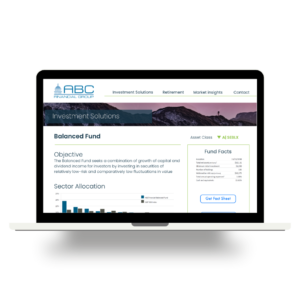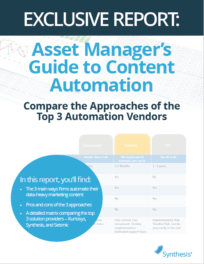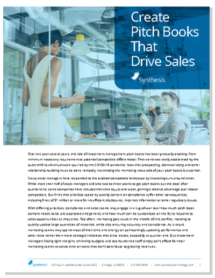Preliminary Research Uncovers Top 5 Criteria for Fact Sheet and Pitchbook Automation

The criteria used to evaluate and select an automation solution vary from firm to firm, but there are some common trends. As part of our ongoing research to understand our customers, prospects, and target market, we make it a regular practice to interview current and potential clients as well as the lead sponsors of lost opportunities. Based on buyer persona research we’ve conducted over the past year, we’ve identified what marketers see as the most important criteria when evaluating and purchasing an automation solution for collateral production. Please note, while this research is largely qualitative and the sample size does not support true statistical measurement, it has shown us some clear and recognizable patterns of decision making and the value systems that drive these patterns. We plan to dig deeper into this research over the next several months and provide a full report. In the meantime, I’m confident that these preliminary findings hold water for the vast majority of asset management marketers.
#1. Flexible Templates/Customization
The ability to personalize content continues to be a growing need for asset managers. Factsheets that are delivered frequently but don’t provide useful information are just annoying. Producing personalized fact sheets becomes more difficult to do when a firm reaches a certain scaling point, which is roughly measured by the number of products and the variety of materials being produced. One marketing executive from a global asset manager I spoke with said she sees personalization as a growing need across the industry. “This has become more tricky in the industry as a whole because everybody has these multi-asset and alternative investment products now and every single one of those has a very different document makeup. For these, maybe 50% is the same as all the other fact sheets, but being able to customize those templates is key to get the most critical components that an FA wants to see.” Automation becomes necessary as a firm grows the volume and variety of investment products they offer, but the automation tool and the templates themselves must be flexible. “If we have a large cap equity product, we would not want to show an asset class breakdown because large cap equities it’s obviously going to be 100% equity; whereas if we have a multi-asset product, we would probably want to show the breakdown of equity, funds and currency.” A data analyst from another firm we spoke to commented that many vendors couldn’t provide the flexibility required to do their strategy fact sheets, “That was something we didn’t see from every vendor. They couldn’t break out the multi-asset funds. You had to assign them to a certain category. For us, charting capabilities and flexibility of output types was a top requirement.” When engaging in vendor selection, ask if you can see samples of fact sheets they’ve produced for multi-asset products and dig-into how this is actually done. If your needs are complex, template flexibility should probably be a the top of your list.
#2. Centralized Content Management
The larger an organization gets, the harder it is to fight the ‘silo’ effect. Information management becomes necessary to manage all of the product language, disclosure, and data that is shared amongst every sales and marketing medium — websites, fact sheets, sales presentations, brochures, commentaries, sales ideas, and one-off pieces. The effort to ensure information is accurate and consistent across every output type can be a monstrous task (i.e. labor intensive) without leveraging technology the right way. One compliance officer we spoke to mentioned the use of two separate systems: one for producing data-heavy, largely templated materials like fact sheets, and another for one-off marketing pieces. This is not a poor document production decision, as the two types of documents require different processes. The challenge is tying the two together somehow to ensure consistency of the data and language. Some automation vendors offer a centralized repository to manage the language, raw data, and visualizations (charts, graphs) for every product that can be used for anything created by any marketing or sales user. Pulling information out of the central system ensures consistency in fact sheets and other marketing and sales assets enterprise-wide. Asset managers we spoke to stressed the need for sharing approved product data and language (especially disclosures) across the organization to enable sales people and drive consistency of messaging in every communication medium.
#3. Ease of Use
Ease of use is a big deal in today’s world — period. In fact, it’s the reason why we’re currently investing hundreds of thousand of dollars into our products to improve user experience. Customers (both marketing and sales people) don’t have much tolerance for technology that is clunky or outdated. In our personal lives, we’re used to navigating around slick-looking apps like Facebook and Pinterest to consume and share information. Online publishers like Shutterfly make it easy for anybody to produce a beautiful photo book or calendar right on the website, using pre-canned template or creating your own from scratch. So in our professional lives, we have little tolerance for tools that require a huge learning curve or a user manual the size of an encyclopedia. Technology and UX design has helped us advance beyond these dark ages. Marketers may have more tolerance than salespeople, but either way the software must deliver a great user experience to ensure adoption and utilization rates. Our research shows that marketers want to be largely self-sufficient, with the option to lean on the vendor for technical expertise as needed. Ask the vendors you’re talking to for a trial of the product. If they don’t offer one (and many won’t), make sure you ask their current customers for feedback on both functionality and ease of use from a real user perspective. Client feedback (i.e. reference calls) are your number one means to unravel the true and lasting impact a vendor has had on their clients. In other words, make sure you’re not buying something that is built on “form over function”. At the end of the day, functionality is king.
#4. Insights/Analytics
Some investment marketers struggle to understand what content is most valuable. For instance, what pitchbook materials are used most? Least? How do you tie individual content back to sales? One marketer said her firm is really looking to improve their understanding of content performance. “We need to get metrics around the usage of our collateral. We also need to streamline operations across our business so that we are not duplicating efforts; looking across our group and getting some efficiencies. We’ve done FA interviews, and they say, ‘Oh, yeah, I get this piece but it goes right in the trash.’ We keeping hearing that. If the piece never gets used why are we spending time and money producing it?” Marketers across all departments (digital and traditional) are becoming more strategic, and they want to use data to get insight into what’s working and what’s not. These usage statistics help marketers focus their efforts on producing the right content and getting into the hands of the sales force more quickly. It also helps strengthen the alignment between sales and marketing teams, which improves sales effectiveness.
#5. Output quality
Marketers are very visual people. We want our work to look polished and enticing. Quality visuals attract and keep the attention of your audience; this is proven. Many marketers fear that automation will compromise or limit the end result of their final fact sheet, commentary, or pitchbook. Automating can degrade the quality of your final output, but it shouldn’t. Ask the vendor what the output file type is. Is it a PowerPoint file converted to a PDF? Is it based on InDesign and converted to a PDF? Is it a custom template? If so, how closely will it match your original designs? How will it handle spilling of text and things like adjusting the leading, etc? How are charts and graphs rendered? Look at final output quality and how the system handles data input and output (visualizations).
Taking a look at fact sheet samples on the vendor’s website is a fine start, but I’ve seen vendors publish client fact sheets that have been “doctored-up” and don’t look at all like what the client’s actually publishing on their website. So, it’s wise to look at actual fact sheets on their clients’ websites and determine the quality for yourself. That’s the beauty of the digital age — a little investigative work on your part can provide you with the proof you need to determine the output quality.
Conclusion
These are all great requirements, and I urge you to consider them when it’s time to start shopping for an automation solution. I’m always surprised, however, that data management doesn’t come up as a top requirement; at least, not without some prodding from a vendor or consultant. Many marketers overlook data management as a key criteria because it’s not (and shouldn’t be) their responsibility to clean-up and prepare data for production. The fact is, however, that this is often the key factor leading to production efficiency and a successful automation implementation. So, I recommend adding Data Management as a #6 and marking it *important* if you find your team spending a lot of time waiting for and cleaning up data before you can begin your process.
When it comes to using automation to produce your key marketing and sales collateral, what product capabilities are most important to you? Do you agree with the ones above? I’d love to hear your thoughts; email me at [email protected] with any criteria you feel are missing from this list.
Here are some related resources that might interest you:






 Compare the Top 3 Finserv Content Automation Vendors [White paper]
Compare the Top 3 Finserv Content Automation Vendors [White paper] Create Pitchbooks the Drive Sales [White paper]
Create Pitchbooks the Drive Sales [White paper] Build vs. Buy: Should Your Financial Services Firm Outsource or Insource Marketing Technology? [White paper]
Build vs. Buy: Should Your Financial Services Firm Outsource or Insource Marketing Technology? [White paper]  10 Tips for Rebranding your Fund Marketing Documents [White paper]
10 Tips for Rebranding your Fund Marketing Documents [White paper]


